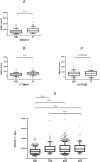Elevation of autoantibody level against PDCD11 in patients with transient ischemic attack
- PMID: 29507658
- PMCID: PMC5823671
- DOI: 10.18632/oncotarget.23653
Elevation of autoantibody level against PDCD11 in patients with transient ischemic attack
Abstract
Background: Disease specific autoantibodies have been detected in the sera of patients with atherosclerosis-related diseases, such as cerebral infarction, cardiovascular disease. In the present study, we aimed to identify novel autoantibodies responsible for transient ischemic attack (TIA), a prodromal condition for cerebral infarction.
Methods: To identify candidate antigens, we screened a human aortic endothelial cell cDNA library using sera from 20 patients with TIA. Serum antibody levels were measured using amplified luminescent proximity homogeneous assay-linked immunosorbent assay (AlphaLISA) in 2 independent patient/healthy donor (HD) cohorts (n = 192 and n = 906 in the second screening and validation cohort, respectively).
Results: First screening identified 3 candidate antigens. Of these, programmed cell death 11 (PDCD11) was determined to be associated with stroke (p < 0.0001), as evidenced from the second screening using AlphaLISA. The validation cohort revealed significantly higher antibody levels against PDCD11 (PDCD11-Ab levels) in patients with TIA than in HDs. Multivariate logistic regression analysis indicated that the predictive value of PDCD11-Ab levels for TIA [Odds ratio (OR): 2.44, 95% confidence interval (CI): 1.33-4.57, p = 0.0039] was not inferior to other known risk factors for ischemic stroke, including age (OR: 4.97, 95% CI: 2.67-9.48, p < 0.0001); hypertension (OR: 3.21, 95% CI: 1.76-5.86, p = 0.0001); and diabetes (OR: 4.31, 95% CI: 1.74-11.2, p = 0.0015).
Conclusion: Serum PDCD11-Ab level may serve as a potential biomarker for TIA.
Keywords: Gerotarget; PDCD11; TIA; autoantibody; biomarker; cerebral infarction.
Conflict of interest statement
CONFLICTS OF INTEREST This work was performed in collaboration with Fujikura Kasei Co., Ltd. GT, RN, NS and HK are employees of Fujikura Kasei Co., Ltd.
Figures



Similar articles
-
Elevation of Autoantibody in Patients with Ischemic Stroke.Neurol Med Chir (Tokyo). 2018 Jul 15;58(7):303-310. doi: 10.2176/nmc.ra.2018-0022. Epub 2018 May 31. Neurol Med Chir (Tokyo). 2018. PMID: 29848906 Free PMC article. Review.
-
Association of serum levels of antibodies against ALDOA and FH4 with transient ischemic attack and cerebral infarction.BMC Neurol. 2021 Jul 9;21(1):274. doi: 10.1186/s12883-021-02301-w. BMC Neurol. 2021. PMID: 34243715 Free PMC article.
-
Elevated levels of autoantibodies against DNAJC2 in sera of patients with atherosclerotic diseases.Heliyon. 2020 Aug 19;6(8):e04661. doi: 10.1016/j.heliyon.2020.e04661. eCollection 2020 Aug. Heliyon. 2020. PMID: 32904265 Free PMC article.
-
Association of serum levels of antibodies against MMP1, CBX1, and CBX5 with transient ischemic attack and cerebral infarction.Oncotarget. 2017 Dec 31;9(5):5600-5613. doi: 10.18632/oncotarget.23789. eCollection 2018 Jan 19. Oncotarget. 2017. PMID: 29464021 Free PMC article.
-
Risk of Subsequent Stroke Among Patients Receiving Outpatient vs Inpatient Care for Transient Ischemic Attack: A Systematic Review and Meta-analysis.JAMA Netw Open. 2022 Jan 4;5(1):e2136644. doi: 10.1001/jamanetworkopen.2021.36644. JAMA Netw Open. 2022. PMID: 34985520 Free PMC article.
Cited by
-
Serum anti‑KIAA0513 antibody as a common biomarker for mortal atherosclerotic and cancerous diseases.Med Int (Lond). 2024 Jun 19;4(5):45. doi: 10.3892/mi.2024.169. eCollection 2024 Sep-Oct. Med Int (Lond). 2024. PMID: 38983794 Free PMC article.
-
Association between serum anti‑ASXL2 antibody levels and acute ischemic stroke, acute myocardial infarction, diabetes mellitus, chronic kidney disease and digestive organ cancer, and their possible association with atherosclerosis and hypertension.Int J Mol Med. 2020 Oct;46(4):1274-1288. doi: 10.3892/ijmm.2020.4690. Epub 2020 Jul 29. Int J Mol Med. 2020. PMID: 32945427 Free PMC article.
-
Serum anti‑TSTD2 antibody as a biomarker for atherosclerosis‑induced ischemic stroke and chronic kidney disease.Med Int (Lond). 2022 Dec 21;3(1):4. doi: 10.3892/mi.2022.64. eCollection 2023 Jan-Feb. Med Int (Lond). 2022. PMID: 36699658 Free PMC article.
-
Elevation of Autoantibody in Patients with Ischemic Stroke.Neurol Med Chir (Tokyo). 2018 Jul 15;58(7):303-310. doi: 10.2176/nmc.ra.2018-0022. Epub 2018 May 31. Neurol Med Chir (Tokyo). 2018. PMID: 29848906 Free PMC article. Review.
-
Combination of high anti-SKI and low anti-TMED5 antibody levels is preferable prognostic factor in esophageal carcinoma.Cancer Sci. 2024 Jul;115(7):2209-2219. doi: 10.1111/cas.16185. Epub 2024 Apr 18. Cancer Sci. 2024. PMID: 38634426 Free PMC article.
References
-
- Chen B, Zhang F, Li QY, Gong A, Lan Q. Protective effect of Ad-VEGF-Bone mesenchymal stem cells on cerebral infarction. Turk Neurosurg. 2016;26:8–15. - PubMed
-
- Ross R, Glomset JA. The pathogensis of atherosclerosis. N Engl J Med. 1976;295:369–377. - PubMed
-
- Ross R. Atherosclerosis — an inflamematory disease. N Engl J Med. 1999;340:115–126. - PubMed
LinkOut - more resources
Full Text Sources
Other Literature Sources
Miscellaneous

